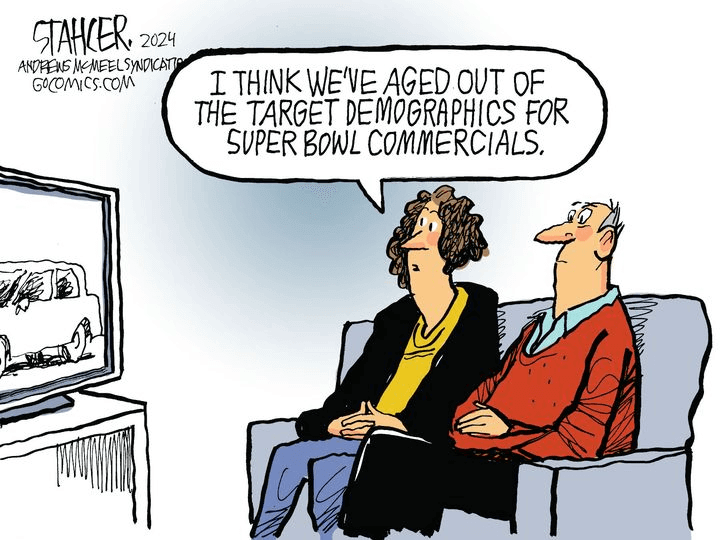
Jeff Stahler (AMS) taps into something that occurred to me during the game. A lot of what they were advertising was of little interest to me, but I also had a sense of “been there, seen that” as creative ideas seemed replaced by celebrity cameos.
Celebrity cameos were once a delightful surprise because they only appeared in a few commercials. When two-thirds of the commercials are based around cameos and little else, well, so what?
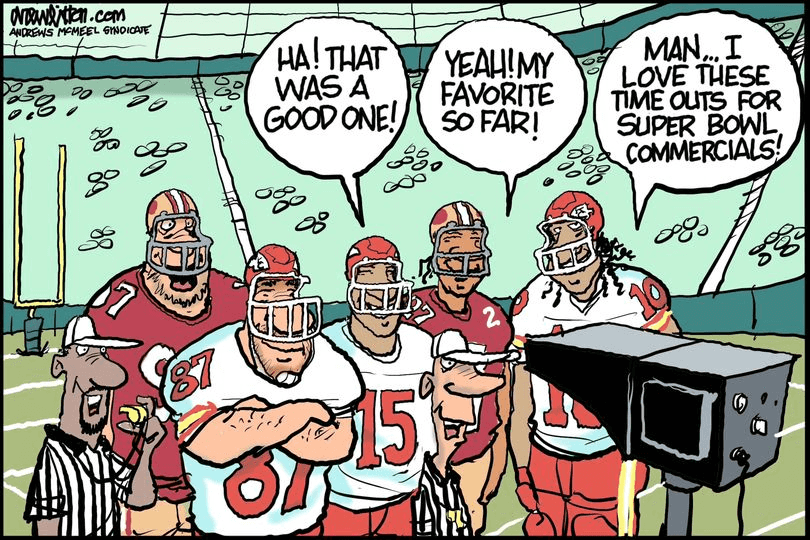
Drew Litton (AMS) and I seem to agree that it felt like they stopped the game a lot longer than normal. I wish it had been for some “good ones.”
We’ll get back to this topic a little later.
Juxtaposition of the Day
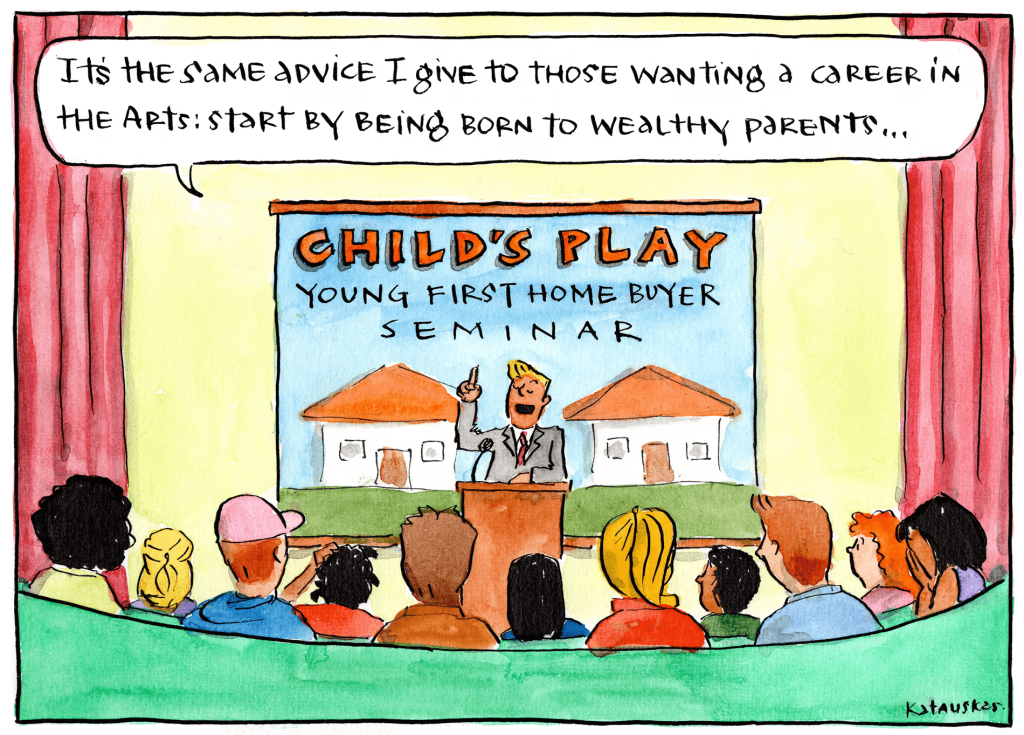

Housing isn’t any more affordable in the US than it apparently is in Australia and the UK.
I like Katauskas’s take because, while political cartoons are under no obligation to be funny, it’s a bonus when they can crack a joke without losing focus, and this is a case of “It’s funny, ’cause it’s true.”
Or, to put it another way, it’s funny but I didn’t laugh because the gag is spot on and it’s more than just a shame. It borders on the criminal.
With luck and persistence, young people can find jobs that should set them up well, but between student loan debt and the cost of rent, they’re lucky to pay their day-to-day bills, never mind saving up for a down payment some time before they turn 50.
I’m not sure Morland’s guru offers a useful solution. Supply-and-demand comes into it, but that’s not the real issue. Rather, it’s a double-whammy of shameless profiteering mixed with genuine increases in construction costs.
We’ve had a shortage of apartments here, which is a problem for employers trying to house their workers, but now I’m seeing a lot of construction. Adam Smith might expect that to result in lower rents, except a lot of the builders are trying to out-luxury each other, such that the ones who include “affordable” units in their plans mean unaffordable but not entirely fabulous.
If an oversupply of housing does bring down prices, it will be because of an overall economic crash and a lot of people will have no money instead of not enough. I’ve seen it happen, and it wasn’t pretty.
The only solution is to ride it out, and that’s no solution at all unless you’ve already got something to ride on.
Juxtaposition of the Day #2.5

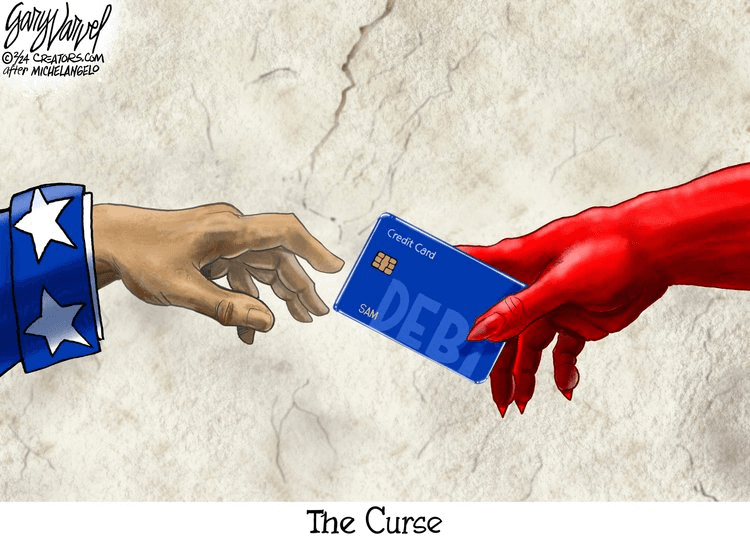
Gary Varvel (Creators) addressed the plight of young Americans, but he did it not as an analysis of the economy but as an attack on Joe Biden, following it up with criticism of government borrowing and the national debt.
Macroeconomic problems impact the microeconomics of the kitchen table, but neither is helped by partisan attacks. The economy is doing quite well right now, and while that hasn’t brought housing prices down, most economic indicators are positive and the uptick is helping individuals.
It’s fair to blame Biden for some of the national debt, though this chart only includes his first two years and the first year of any administration runs on the budget of its predecessor.
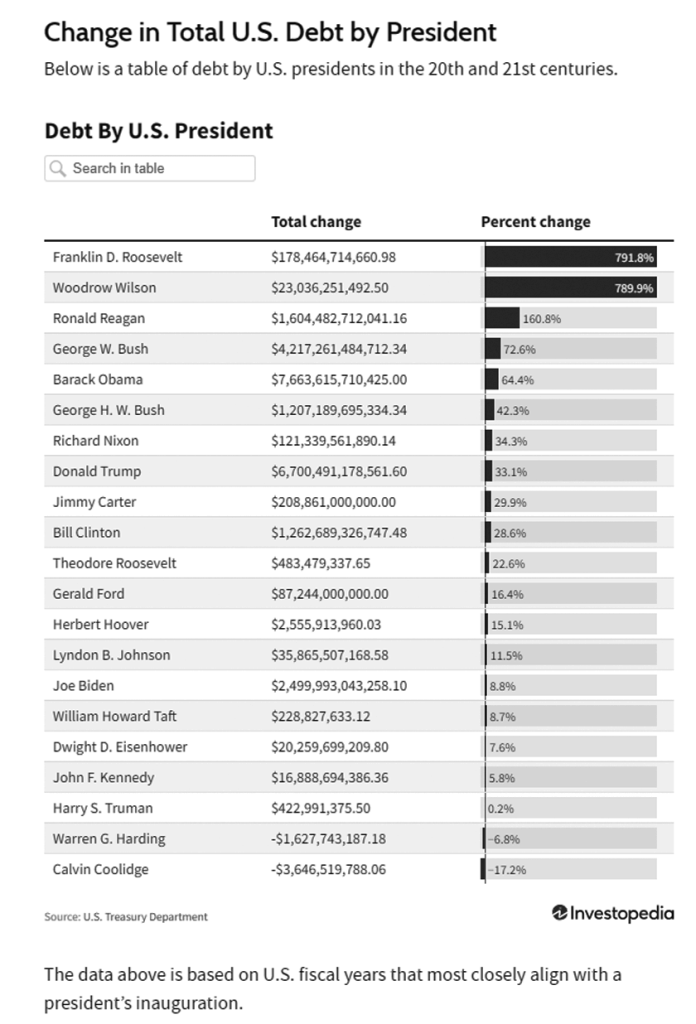
Fighting a world war is expensive, as you’ll see there at the top, but if Biden’s partial results make him look thrifty, a glance at party affiliations overall doesn’t make the Republican Party look all that good.
But the crucial factor is all the other factors: Obama’s numbers look bad because he was cleaning up after the catastrophic crash under W, while Reagan’s debt piled up in large part because of his tax cuts. And no president has nearly as much control over any of it as does the Congress.
History majors won’t get too excited about the savings under Harding and Coolidge, either, because they know how the economy fared after those two had handled it.
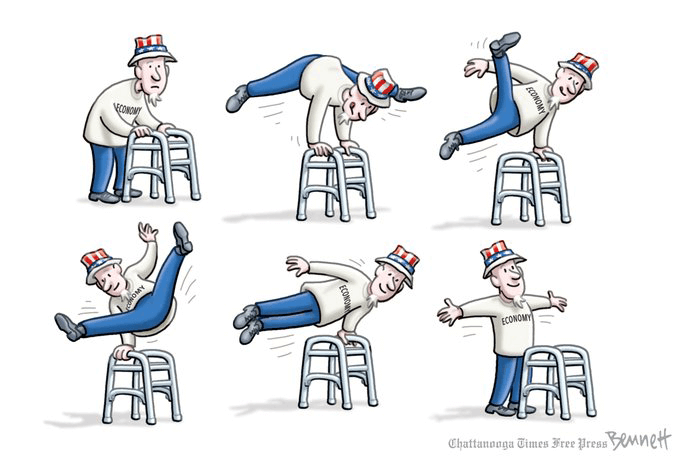
As for the kitchen table, it’s only fair to point out that Bidenomics, in addition to bringing lower unemployment, falling inflation rates and a rising stock market, spent on stimulus payments during the pandemic as well as a more generous child tax credit.
It doesn’t all fit in that chart and it’s even harder to fit it into a cartoon, though Clay Bennett (CTFP) summarizes the big picture by breaking it up into six little pictures.
Meanwhile, out in the parking lot …
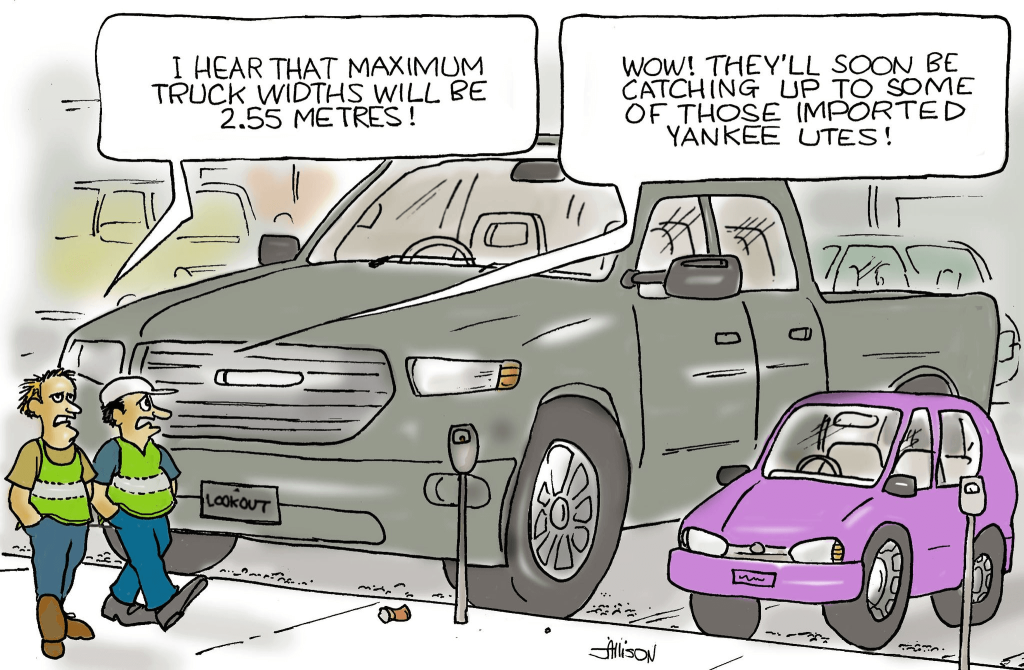
John Allison casts a worried eye at the problem of bulbous vehicles, as Australia looks at increasing the width of parking spaces to accommodate the nation’s love affair with big vehicles.
I get annoyed at not being able to see around the damn things, but here’s a story that goes beyond inconvenience at intersections and in parking lots: Turns out guard rails were designed for sensible-sized cars and the bulbous ones can plow right through.
Which I guess is one solution. All I was going to propose was setting license fees by weight.
Juxtaposition of the Deity
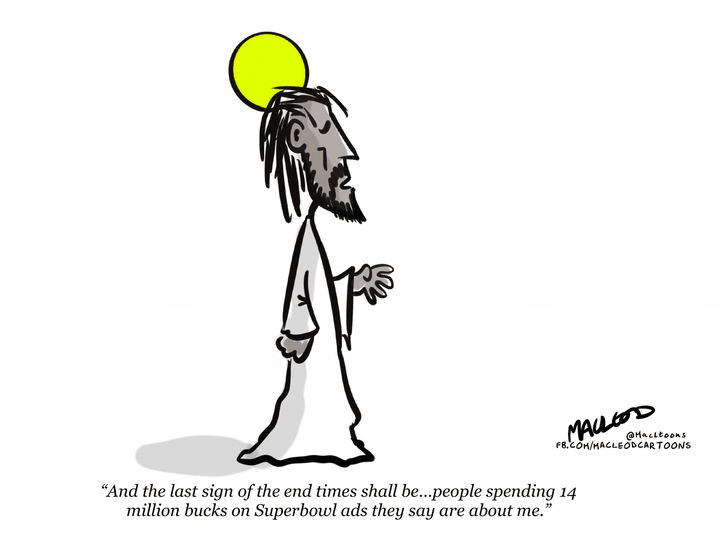
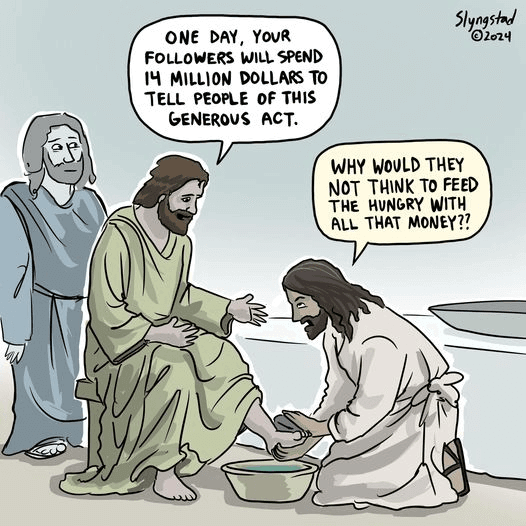
I liked it better when the next-day chatter was about frogs saying “Bud-Why-Zer,” but the Super Bowl ads I’ve seen the most talk about were the “He Gets Us” ads, from people who, like these cartoonists, were angry that money was spent to inspire acceptance, kindness and agape rather than directly in charitable contributions.
Part of it stems from the fact that the group gets major financial support from Hobby Lobby, noted for its refusal to fund birth control for employees and its lobbying for anti-LGBTQ+ laws.
Fair enough — I don’t shop there or eat at Chik-Fil-A — but the company has stepped back from controlling the non-profit, which is purposefully non-denominational and, in fact, includes a message of love for the LGBTQ+ community on its website:

There’s a vocal element of people on-line who hate religion because of how they were treated by specific people in specific churches, but they may get some comfort from knowing that those whited sepulchres were also offended by the ads.
In any case, it’s appropriate to have people criticize the cost of that foot-washing spot. Matthew recorded precisely WWJD:

However, yes, it’s true: They could, instead, have given $21.44 to every homeless person in America, or 76 cents to each child who is on public assistance.
Though not both.
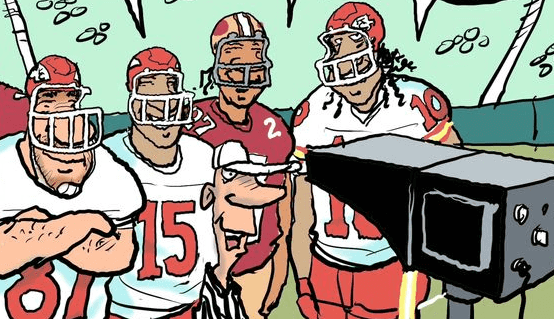
Super Bowl ad I would like to have seen…
A montage of Nazi/White Nationalist rallies, book burnings, etc., finishing up with footage of the Jan. 6 storming of the Capitol, fade to black, then to the image of Trump with his insufferably smug smirk, then fade in the caption, “HE GETS YOU”.
Why not do a cartoon of that?
In this case, actual footage would be far more effective than a cartoon.
Love it !
David Ogilvy – who was often called the world’s greatest advertising man when he was alive – opposed celebrity endorsements, because they cost a ton of money and took attention AWAY from the product you were actually trying to sell, at least if there was no real connection between the celebrity and the product. . He said if you could get Vladimir Horowitz to endorse your piano, that made sense. If he was endorsing your deodorant, nobody cared.
When he was younger, he got Eleanor Roosevelt to endorse Good Luck Margarine. It sold no margarine, and he was embarrassed about it for the rest of his life.
Funny bit when Rachel from Friends didn’t remember Ross. Ha. But I have no idea what they were advertising. It was something about memory loss?
How many tiny houses or low rent apartments could be built for $14 million? How many down payment zero interest loans to those youngsters needing down payment help?
Or, they could have bought and forgiven $1.4 billion of medical debt.
If you know a way to settle medical debt at that rate, please share.
https://ripmedicaldebt.org/
https://ripmedicaldebt.org/
This charity does exactly that.
I assume that is what they are talking about.
Interesting group. I imagine the people they help really need it, since it sounds like they’re stepping in in place of a collection agency. Good for them. Note, of course, that any company that bought a Super Bowl ad could have done this, not just the group that was encouraging compassion. But, yes, a good place to make a donation.
Coincidentally, there is today’s news story:
https://stateline.org/2024/02/13/governments-can-erase-your-medical-debt-for-pennies-on-the-dollar-and-some-are/
I greatly appreciate your wide-ranging coverage; sometimes have to wonder why I have to go to a column about comics to hear anything about an important topic like that guardrail issue.
Thank you, Mike!
Post WW2 many 1000 sq ft homes were built to address housing shortage needs. These served as lifetime homes for many and starting homes for others. Now ,developers view cornfields and see future expensive neighborhoods with 3000 sq ft homes. Starter homes and “affordable” housing will come from the existing stock in the foreseeable future
Bear in mind that those postwar chicken coops were affordable when they were built, especially with the number of GI loans available to those young couples. They didn’t come down in price because they didn’t have to. My experience covering the housing market in Colorado was that, when things collapsed, there were a ton of repo’s, but a ton of unemployed people who couldn’t afford them either. And, boy, you oughta see what happens to property taxes when half the neighborhood is standing vacant but there’s still just as much sidewalk and street lamps and sewer lines to pay for.
As I said above, the only way housing prices come down is in a disaster, and you don’t want one.
BTW, I just looked at the post-war chicken coop that was my starter home in Denver. We paid $23,000 in 1972, which, with inflation is the equivalent of $168,895 today. Zillow says the house would sell now for $476,400. That’s not inflation; it’s greed. And if you did sell for less, where would you live next?
I’m just glad I’m not the only one who hates those huge, impossible-to-see-around trucks and SUVs.
OMG. Hilarious, but not funny!
I laughed so hard here in my apartment where I am warm and cozy. All the while they closed the women”s shelter because it wasn’t 35 degrees. WHAT?
Homeless women sleeping outside. OMG